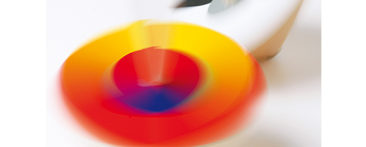On December 22, 1976, Hans Maria Wingler, who at that time was the head of the Bauhaus Archive in Berlin, wrote to Kurt Naef: “The Bauspiel (building toy) is met with my full approval. It demonstrates what beautiful production quality one can expect from Naef. Therefore, I would certainly agree to have the building game produced in this quality.” This correspondence was regarding the reproduction of the Schiffsbauspiel (ship construction toy) designed by Alma Siedhoff-Buscher, but also about the production of the Optischen Farbenmischer (optical color mixer) by Ludwig Hirschfeld. Kurt Naef proved to be the one who had the technical know-how and could deliver the sought-after quality. He was familiar with the Bauhaus toys from books and was also interested in adding some of the Bauhaus toys to his own assortment. He managed to secure the production rights not only for the Bauhaus Bauspiel (building toy) and the Optischen Farbenmischer (optical color mixer), but also for the chess pieces by Josef Hartwig and – in cooperation with the Bauhaus Dessau Foundation – for the Steckpuppen (stick puppets) and the Hampelmann (jumping jack puppet) by Margaretha Reichardt.
Next year, (2019) Bauhaus celebrates its 100th birthday. It is considered the most influential school of art, design and architecture of the 20th century. Although it only lasted only 14 years due to political circumstances, it was a very productive time. Influential artists, designers and architects and revolutionary ideas emerged, whose influence has continued into the present day. Some Bauhaus alumni were also involved with the development of toys, preferred wood as their media, and chose bold colors. Toys should bring joy, evoke fantasy, but also fulfill a didactic purpose, namely to stimulate the imagination. Learn more about the designers.
In 1960, the art historian Klaus Maria Wingler founded the Bauhaus Archive, an association whose goal was to compile a Bauhaus collection in order to let its ideas live on. Through catalogs, exhibitions and lectures, the Bauhaus heritage was made world famous. As a result, interest in the designs of the past grew; in the early 1970s, a number of furniture and utility objects appeared on the market as licensed re-editions.
For over 40 years, the Bauhaus replicas have enriched the Naef product range and are still in high demand. On the one hand they are part of a pioneering era, and on the other hand they are timeless classics.





